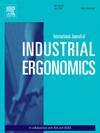Neck muscle fatigue due to sustained neck flexion during smartphone use
Abstract
A laboratory experiment evaluated local muscle fatigue development in the neck extensor muscles during prolonged smartphone use in sitting. Twenty young adults conducted a smartphone task for 45 min in supported sitting, with the mean head tilt angle of 30.4°–34.6° from neutral upright. The mean amplitude and median power frequency of the electromyography (EMG) signals of the cervical erector spinae muscles were quantified during the smartphone task and in intermittent sub-maximal isometric neck extension trials. Data showed an increasing and decreasing trend of the mean amplitude and the median power frequency over time, respectively. Still, the statistical significance of the time effect was not found consistently. The median power frequency of the right neck extensor muscle differed significantly (p < 0.05) between the trials but did not indicate fatigue development. Study results suggest that smartphone use in common supported sitting for 45 min, although subjective rated neck discomfort increased significantly, did not produce significant fatigue in the superficial neck extensors. Investigation into the mechanism of neck discomfort due to intensive smartphone use would require a comprehensive evaluation of time-dependent changes in the passive tissues and synergistic activation of deeper cervical spine muscles.

 求助内容:
求助内容: 应助结果提醒方式:
应助结果提醒方式:


